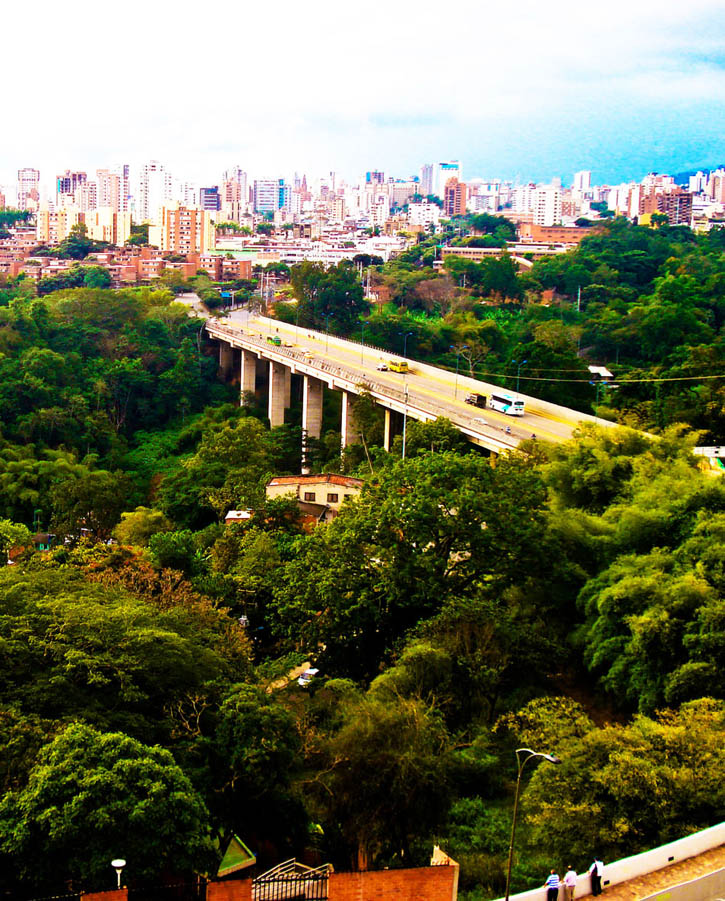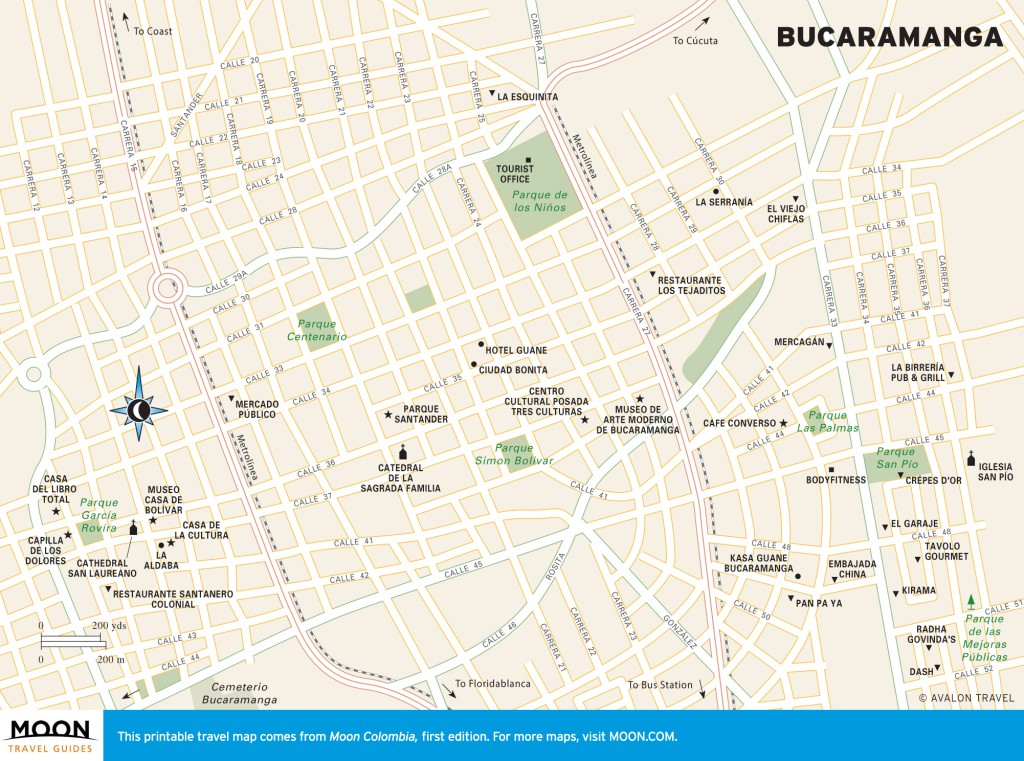The Ciudad Bonita (Beautiful City) is the capital of the department of Santander. Bucaramanga is a busy and growing city with a young and vibrant population and an agreeable climate where the flowers are always in bloom. Its central location makes for a strategic launching point for visits to the Santander countryside and is a midway point between Bogotá and Santa Marta on the Caribbean coast as well as Cúcuta in the far east. Including neighborhoods that are an extension of Bucaramanga (Floridablanca, Girón, and Piedecuesta), the population exceeds a million.
Carreras (avenues) run north to south, increasing in number from west to east. The main carreras are 15, 27, and 33. Calles (streets) run east to west and increase in number from north to south.

Bucaramanga is the modern capital city of Santander. Photo © Alejandra Triana Muñoz/123rf.
Bucaramanga’s main sights are contained within the walkable city center. If you’re staying in the Cabecera neighborhood it’s a long, hot walk to the city center, so you’re better off taking a cab.
Bucaramanga prides itself on its parks, and one of the most famous is the Parque García Rovira (Cras. 10-11 and Clls. 36-37). Filled with towering palms, it doesn’t provide much shade, but with the pale yellow and white 19th-century Catedral San Laureano (Cra. 12 No. 36-08) standing prominently on the park’s eastern side, it is rather photogenic. On the west side of the park is Bucaramanga’s oldest church, the Capilla de los Dolores (Cra. 10 No. 36-08). This unassuming, white-washed structure dates back to 1748 and no longer has a religious mission. It’s generally not open to the public. Across from it is La Casa del Libro Total (Cl. 35 No. 9-81, tel. 7/630-3389, 8am-10pm Mon.-Fri.), a newish cultural center that (oddly) has a number of bank offices and at the same time exhibition spaces (air-conditioned) for interesting art exhibits. There is also a small library, and a café serves free coffee.
The Libertador, Simón Bolívar, stayed in his friend Juan Eloy Valenzuela’s house, now known as the Museo Casa de Bolívar (Cl. 37 No. 12-15, tel. 7/630-4258, 8am-noon and 2pm-6pm Mon.-Fri., 8am-noon Sat., COP$2,000) for about 70 days in 1828 while he awaited news from the Convención de Ocaña. (Things went badly at that convention, with a rift between Bolívar and Santander growing wider, and the end result was Bolívar’s self-declaration as dictator.) The museum has personal belongs of the Liberator, an original diary from the first Expedición Botánica led by José Celestino Mutis, an original shield of the Estados Unidos de Colombia, and an exhibit on the Guane indigenous people from the area.
Across the street from the Museo Casa de Bolívar, the Casa de la Cultura (Cl. 37 No. 12-46, hours vary) hosts occasional art exhibitions and other events. The restaurant on the first floor is packed at lunchtime.

Bucaramanga
Five or six blocks to the east is the Parque Santander (Cras. 19-20 and Clls. 35-36). It’s a lively park in the middle of the hustle and bustle of modern Bucaramanga. Hare Krishnas beat drums, unimpressed skateboarders show off, and dozens others look on. The Romanesque Revival Catedral de la Sagrada Familia (Cl. 36 No. 19-56) took over a hundred years to complete. It was finished in 1865. Some of the most striking features inside include the many stained glass windows. The church, with twin towers and statues of the Virgin Mary, the baby Jesus, and Joseph in between, looks particularly grandiose at night when it is lit.
The Museo de Arte Moderno de Bucaramanga (Cl. 37 No. 26-16, tel. 7/645-0483, 8:30am-noon and 2pm-5:30pm Mon.-Fri., 8am-noon Sat., COP$2,000) is worth checking out, but it’s only open when there is an exhibit. The Centro Cultural Posada Tres Culturas (Cl. 37 No. 24-62, tel. 7/683-9142, 9am-noon and 2pm-7pm Mon.-Sat.) is near the museum and often has events going on. It has a nice art bookstore.
The Parque San Pío (between Cras. 33-35 and Clls. 45-46) is a vibrant greenspace near the Cabecera neighborhood. At the western end stands the Fernando Botero sculpture Mujer de Pies Desnuda. On the opposite end is the modern Iglesia San Pío (Cra. 36 No. 45-51), where there are paintings on permanent display by local artist Oscar Rodríguez Naranjo. Farther up is the Museo Guane at the Universidad Autónoma de Bucaramanga (UNAB, Av. 42 No. 48-11, tel. 7/643-6111), which has a collection of over 600 ceramic pieces (figures, ceremonial and daily vessels, shell necklaces, stone utensils, and ceramic spindle whorls) found near Bucaramanga. Some 90 pieces are on display in a small lobby area. Nobody seems to know where the exhibition space is, and you’ll have to ask around. You may have to climb around lounging students to even get a look at the collection.
Excerpted from the First Edition of Moon Colombia.